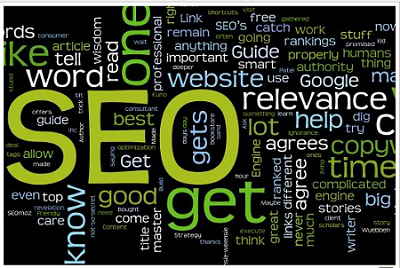Infographic: What are Google's 200 Ranking Factors for SEO?
By Jaco Grobbelaar on Mon, Jun 10, 2013 @ 06:53 AM

 Search engine optimization, known affectionately by its friends as SEO, is an overwhelmingly difficult topic to base a blog article on. However, I have found the ideal infographic that covers the whole thing—content and keywords, inbound links, social media and all. Before I overwhelm you with this behemoth we need to take a few minutes to look at content, links and social from the eyes of a couple of SEOs, which in this case means search engine optimizers.
Search engine optimization, known affectionately by its friends as SEO, is an overwhelmingly difficult topic to base a blog article on. However, I have found the ideal infographic that covers the whole thing—content and keywords, inbound links, social media and all. Before I overwhelm you with this behemoth we need to take a few minutes to look at content, links and social from the eyes of a couple of SEOs, which in this case means search engine optimizers.
In two posts SEO Jayson DeMers, who writes for Search Engine Journal, Search Engine Watch, Huffington Post and Forbes (are you as impressed? You should be.) gives the background for the discussion of how to create good SEO for your website and business. In his article The Three Pillars Of SEO In 2013: Content, Links, And Social Media in Forbes Magazine in May 2013, Jayson says:
In 2013, success in SEO hinges on businesses putting together a robust combination strategy that brings together an integrated web of great content, credible links, and social signals. Each of these pieces supports the other, providing tremendous value to readers, building your authority and brand value, and distributing your content across new channels. . . .
The world of SEO is definitely complex, and in 2013 a simplistic legacy approach is no longer enough. Effective SEO requires managing different elements, ranging from your content and keywords to your social media and link building activities. But with a focus on these three pillars, you can create a foundation and structure that will support a high ranking site for a long time to come.
Webspam? Pondscum?
You will have a chance to look at these items in great (and I mean great) detail shortly.
 In Jayson’s article Penguin 2.0: Your Roadmap to Recovery in Search Engine Journal also in May 2013, he talks briefly about something called “webspam” (you will see this term later):
In Jayson’s article Penguin 2.0: Your Roadmap to Recovery in Search Engine Journal also in May 2013, he talks briefly about something called “webspam” (you will see this term later):
"I’m optimistic. Penguin 2.0 is still very new, and there’s still much to be learned about what has changed. But if we learned anything from Penguin 1.0, it’s that the Penguin targets webspam. Most often, that webspam is in the form of unnatural or manipulative inbound links. . . .
"Gain reputable, credible, and authoritative inbound links. Links have been and will be important for the foreseeable future. Links are the great battleground of the search engine algorithm changes. Why? Some SEOs, in an effort to boost a page’s presence on the SERPs, would build thousands of spammy backlinks. The more links, the better, right? Wrong. The algorithms figured out which sites don’t deserve credibility, and distinguishes them from the ones that are truly valuable. Now, sites that are spammed with shoddy links are getting hit hard by penalties. Whether you’re guest blogging or consulting with an SEO agency that provides link building services, insist on only the highest quality links for your site."
Now let’s move closer to the infographic and look at Eric Siu’s article in June 2013 A Look at Google's 200 Search Ranking Factors (Infographic) Eric says:
Maintaining and improving your website's search engine optimization (SEO) can be exhausting. Every time search giant Google changes its algorithm, business owners and their webmasters are left with their heads spinning, trying to make adjustments so their sites don't fall in Google's search rankings.
Most recently, Google rolled out Penguin 2.0, a newer version of its previous Penguin algorithm update, which aims to cut down on web spam.
While trying to keep on all of Google's changes can be a hassle, there are a large number of SEO factors that are unlikely to change any time soon. To help make SEO just a little easier, digital marketing firms Backlinko and Single Grain have created the infographic below, collecting some 200 factors that Google considers when ranking sites in its search results. The information was compiled from hundreds of sources, including SEO blogs and from statements made by Google's head of web spam, Matt Cutts.
Eric goes on to talk briefly about content and targeted keywords. These need to be in your website’s title tags because they help your business perform better than pages that don’t have targeted words in the title tags. Next, he mentions backlinks. His simple advice is that the more links pointing to your site the better. And then our third item—Social. Google is paying attention to retweets, Facebook share and Google +.
Do Not Panic!
Then Eric puts up the whole Google 200 ranking factors.
- Don’t try to take in too much of this in one sitting.
- Be sure that you save it to a drawing site so you get it in its entirety.
- Then just work on one piece at a time.
- Be care you aren’t considered pondscum, I mean, webspam!

I hope this clears up as much as possible how Google works. If you have any questions, please call us or click the button below for a Complimentary Inbound Marketing Session.
Word Art: http://i940.photobucket.com/albums/ad246/mosheco/seologo.jpg
Penguin: http://img.photobucket.com/albums/v297/Kyucerea/penguin.jpg
Infographic by Backlinko and Single Grain

Jaco Grobbelaar is the owner of BroadVision Marketing. BroadVision Marketing works with business owners to put in place inbound and outbound marketing strategies that consistently secure new clients. The BroadVision Marketing Training Center is located in Petaluma, CA and primarily serves companies in the San Francisco Bay area.
Jaco can be reached at jaco@broadvisionmarketing.com or 707.766.9778 or connect with Jaco on Facebook - www.facebook.com/broadvisionmarketing - and LinkedIn - www.linkedin.com/in/JacoGrobbelaar.
You May Also Like
These Related Stories

Another Keyword Article about Google Hummingbird and SEO Part 2

Google Plus for Inbound Marketing [Infographic]

.png?width=302&height=75&name=BVM%20Logo%20-%20transparent%20(1).png)


Comments (8)